American Pit Bull Terrier
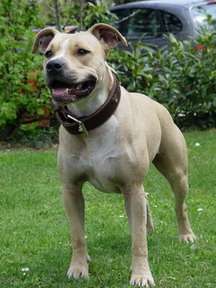 | |||||||||||||||||||||||||||||||||
| Common nicknames | APBT, Pit Bull, Pit | ||||||||||||||||||||||||||||||||
|---|---|---|---|---|---|---|---|---|---|---|---|---|---|---|---|---|---|---|---|---|---|---|---|---|---|---|---|---|---|---|---|---|---|
| Origin |
United States, United Kingdom[1] | ||||||||||||||||||||||||||||||||
| |||||||||||||||||||||||||||||||||
| |||||||||||||||||||||||||||||||||
| Domestic dog (Canis lupus familiaris) | |||||||||||||||||||||||||||||||||
The American Pit Bull Terrier (APBT) is a dog breed.[2] It is a medium-sized, solidly-built, short-haired dog whose early ancestors came from the British Isles. A member of the molosser breed group, both the American Staffordshire Terrier and the American Pit Bull Terrier (APBT) were bred from the same lineage, but received different names from the two American kennel clubs; American Staffordshire Terrier was the name given by the American Kennel Club (AKC), and American Pit Bull Terrier by the United Kennel Club (UKC). When compared with the English Staffordshire Bull Terrier (another breed within the type commonly called pit bulls), the American Pit Bull Terrier is larger by margins of 6–8 inches (15–20 cm) in height and 25–35 pounds (11–16 kg) in weight. The American Pit Bull Terrier varies in size. Males normally are about 18-19 inches (45-48 cm) in height and around 35-63 pounds (15-29 kg) in weight. Females are normally around 17-18 inches (43-45 cm) in height and 30-57 pounds (13-26 kg) in weight.
The American Pit Bull is medium-sized, and has a short coat and smooth well-defined muscle structure. Its eyes are round to almond-shaped, and its ears are small to medium in length, typically half prick or rose in carriage. The tail is slightly thick and tapers to a point. The coat is glossy, smooth, short, and stiff to the touch. The accepted coat color can vary widely, but, both the AKC and UKC do not recognize merle coloring. Color patterns that are typical in the breed are spotted, brindled, solid, and with points.
Twelve countries in Europe, as well as Australia, Canada, Ecuador, Malaysia, New Zealand, Puerto Rico, Singapore, and Venezuela have enacted some form of breed-specific legislation on pit bull-type dogs, including American Pit Bull Terriers, ranging from outright bans to restrictions and conditions on ownership. The state of New South Wales in Australia places restrictions on the breed, including mandatory sterilization. The breed is banned in the United Kingdom, in the Canadian province of Ontario,[3] and in many locations in the United States.
History
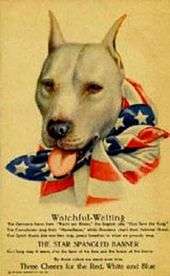
The Pit Bull Terrier was created by breeding Old English Terriers and Old English Bulldogs together to produce a dog that combined the gameness of the terrier with the strength and athleticism of the bulldog.[4] These dogs were bred in England, and arrived in the United States where they became the direct ancestors of the American Pitbull Terrier. In the United Kingdom, pit bulls were used in bloodsports such as bull baiting, bear baiting. These bloodsports were officially eliminated in 1835 as Britain began to introduce animal welfare laws. Since dogfights were cheaper to organise and far easier to conceal from the law than bull or bear baits, bloodsport proponents turned to pitting their dogs against each other instead. Dog fighting was used as both a bloodsport (often involving gambling) and a way to continue to test the quality of their stock. For decades afterwards, dog fighting clandestinely took place in small areas of Britain and America. In the early 20th century, pitbulls were used as catch dogs in America for semi-wild cattle and hogs, to hunt, and drive livestock, and as family companions.[4] Some have been selectively bred for their fighting prowess.[5][6]
Pit Bull Terriers successfully fill the role of companion dogs, and police dogs,[7][8] and therapy dog.[9] Pit Bull Terriers also constitute the majority of dogs used for illegal dog fighting in America[10] In addition, law enforcement organisations report these dogs are used for other nefarious purposes, such as guarding illegal narcotics operations,[11][12] use against police,[13] and as attack dogs.[14]
In an effort to counter the fighting reputation of pit bull-type dogs, in 1996 the San Francisco Society for the Prevention of Cruelty to Animals renamed pit bull terriers to "St. Francis Terriers", so that people might be more likely to adopt them.[15] 60 temperament-screened dogs were adopted until the program was halted, after several of the newly adopted pit bulls killed cats.[16] The New York City Center for Animal Care and Control tried a similar approach in 2004, relabeling their pit bulls as "New Yorkies", but dropped the idea in the face of overwhelming public opposition.[17][18]
Temperament
The UKC gives this description of the characteristics of the American Pit Bull Terrier:
The essential characteristics of the American Pit Bull Terrier are strength, confidence, and zest for life. This breed is eager to please and brimming over with enthusiasm. APBTs make excellent family companions and have always been noted for their love of children. Because most APBTs exhibit some level of dog aggression and because of its powerful physique, the APBT requires an owner who will carefully socialize and obedience train the dog. The breed’s natural agility makes it one of the most capable canine climbers so good fencing is a must for this breed. The APBT is not the best choice for a guard dog since they are extremely friendly, even with strangers. Aggressive behavior toward humans is uncharacteristic of the breed and highly undesirable. This breed does very well in performance events because of its high level of intelligence and its willingness to work.[19]
In September 2000, the United States Centers for Disease Control and Prevention (CDC) published a study which examined dog bite-related fatalities (human death caused by dog bite injuries) in order to "summarize breeds of dogs involved in fatal human attacks during a 20-year period and to assess policy implications."[20]
The study examined 238 fatalities between 1979 and 1998 in which the breed of dog was known. It found that "the data indicates that Rottweilers and pit bull-type dogs accounted for 67% of human DBRF [dog bite-related fatality] in the United States between 1997 and 1998" and that it was "extremely unlikely that they accounted for anywhere near 60% of dogs in the United States during that same period and, thus, there appears to be a breed-specific problem with fatalities."[20]
However, the article continued, saying that care should be taken in drawing conclusions based on these data because:
- first, the study likely covered only about 74% of actual DBRF cases;
- second, records of DBRF may have been biased by the propensity of media to report attacks by certain breeds over others;
- third, it is not always straightforward to identify a dog's breed, and records may be biased towards reporting 'known' aggressive breeds; and
- fourth, it was not clear how to count mixed breeds.
- fifth, such breeds have traditionally been used in dog fighting at a far higher percentage than others. Thus, the disparity of docility versus aggressiveness tends to rank very highly in Rottweilers and pit bull-type dogs when compared to other breeds, with human training playing the primary role.
The authors concluded by noting that "breeds responsible for human DBRF have varied over time" (for example, Great Danes caused the most reported DBRF between 1979 and 1980). In the face of this inconclusive data, the study authors recommended that breed should not be the "primary factor driving public policy", instead making the following policy recommendations: "adequate funding for animal control agencies, enforcement of existing animal control laws, and educational and policy strategies to reduce inappropriate dog and owner behaviors" as likely to be beneficial and specifically to decrease the occurrence of dog bites.[20]
In a peer-reviewed literature review of 66 dog bite risk studies, the American Veterinary Medical Association determined that "breed is a poor sole predictor of dog bites. Controlled studies reveal no increased risk for the group blamed most often for dog bites, ‘pit bull-type’ dogs. Accordingly, targeting this breed or any another as a basis for dog-bite prevention is unfounded. As stated by the National Animal Control Association: "Dangerous and/or vicious animals should be labeled as such as a result of their actions or behavior and not because of their breed."[21]
In 2014, new statistical evidence emerged regarding the province-wide ban on "pit bulls", more specifically the American Pit Bull Terrier and Staffordshire Terrier, in the Canadian province of Ontario. It was reported to show that since the ban had been implemented, dog bites involving the two breeds and dogs of their likeness had dropped considerably in the province's largest city Toronto,[22] yet overall dog bites hit their highest levels this century in 2013 and 2014.[23]
Health
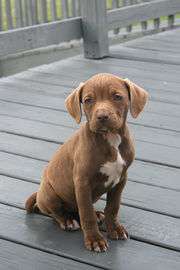
The breed tends to have a higher than average incidence of hip dysplasia.[24] Culling for performance has helped eliminate this problem and others such as patella problems, thyroid dysfunction and congenital heart defects.[25] American Pit Bull Terriers with dilute coat colors have not had a higher occurrence of skin allergies as other breeds.[26] As a breed they are more susceptible to parvovirus than others if not vaccinated, especially as puppies, so vaccination is imperative beginning at 39 days old and continuing every 2 weeks until 4 months old. Then again at 8 months. Once a year after that, as recommend for all breeds.[27]
They are very prone to Demodex Mange due to culling for performance. There are two different types of Demodex Mange, namely Localized and Generalized Demodex. Although it is not contagious it is sometimes difficult to treat due to immunodeficiency in some puppies. The Localized symptoms are usually loss of hair in small patches on the head and feet of the puppies. This type will usually heal as the puppies grow and their immune systems grow stronger. The second type which is Generalized Demodex mange is a more severe form of the sickness. The symptoms are more severe and include loss of hair throughout the entire body and the skin may also be scabby and bloody. Generalized are usually hereditary due to immunodeficiency genes that are passed on from Sire and Dam to their puppies. A simple skin scraping test will allow the vet to diagnose demodex mange. The most widely used method to treat Demodex Mange is ivermectin injections or oral medications. Since Demodex Mange lives in the hair follicles of the dog, Ivermectin will kill these mites at the source.[28]
Varieties
Old Family Red Nose
Old Family Red Nose (OFRN) is an old strain of American Pit Bull Terriers known for their specific reddish coloration. A dog of the red-nosed strain has a copper-red nose and coat, red lips, red toe nails, and red or amber eyes.[29]
Blue Nose Pitbull The blue nose pitbull is known to have a blue coloring of their fur, but the name comes from the dog having a blue nose. The blue coloration is a rare coloring and cannot be found in other breeds. [30]
History
In the middle of the 19th century, there was a breed of pit dogs in Ireland that were known as "Old Family." At that time, all the strains were closely inbred with each family clan. Since red is recessive to all colors but white, the breed was known as "Irish Old Family Reds." When the dogs began coming to America, they were already showing the red nose.
The "Old Family Reds" dogs found their way to America mainly via Irish immigrants though many in the United States did import the breed.
Many strains have been crossed with the Old Family Reds at some time in their existence. This is how the breed of American Pit Bull Terrier was created. Consequently, nearly any strain will occasionally throw a red-nosed pup. To many dog owners, these red-nosed individuals are Old Family Red Noses even though the great preponderance of their blood is that of other strains. Sometimes such individuals will fail to measure up and thereby reflect undeserved discredit on the red-nosed strain. However the Old Family Reds produced more than their share of good ones unlike other strains are known. Old Family Reds were sought after for their high percentage in ability to produce deep gameness.
Originally renowned for its gameness, it continues to be bred to maintain its unique reddish color. Some of the most reputable breeders in all Pit Bull history such as Lightner, McClintock, Hemphill, Williams, Menefee, Norrod and Wallace have contributed to the preservation and development of the strain. Finally, as McNolty said in his 30-30 Journal (1967) "Regardless of one's historical perspective, these old amber-eyed, red-nosed, red-toe-nailed, red-coated dogs represent some of the most significant pit bull history and tradition that stands on four legs today."
Activities
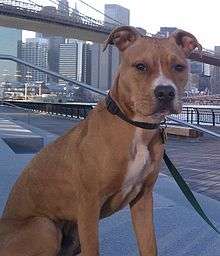
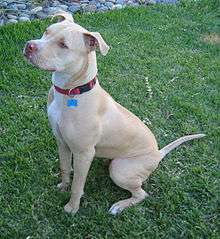
American Pit Bull Terriers excel in many dog sports, including weight pulling, dog agility, flyball, lure coursing, and advanced obedience competition. Out of the 115 dogs who have earned UKC "superdog" status (by gaining championship titles in conformation, obedience, agility, and weightpull), 34 have been American Pit Bull Terriers, and another 13 were American Staffordshire Terriers.[31][32]
The American Pit Bull Terrier is a working dog, and is suitable for a wide range of working disciplines due to their intelligence, high energy, and endurance. In the United States they have been used as search and rescue dogs,[33] police dogs performing narcotics and explosives detection,[34][35] Border Patrol dogs, hearing dogs to provide services to the deaf, as well as general service dogs. In the South they are often a favorite dog for catching feral pigs.
Law
Australia,[36] Ecuador,[37] Malaysia,[38] New Zealand,[39] the territory of Puerto Rico,[40] Singapore,[41] Venezuela[42] Denmark, Israel,[43] France, Germany, Norway, Poland, Portugal, Romania, Spain and Switzerland[44] have enacted some form of breed-specific legislation on pit bull-type dogs, including American Pit Bull Terriers, ranging from outright bans to restrictions on import and conditions on ownership.[44][45] The state of New South Wales in Australia places restrictions on the breed, including mandatory sterilization.[46][47]
Certain counties and cities in the United States have banned ownership of the American Pit Bull Terrier, as well as the province of Ontario in Canada.[44][48] American Pit Bull Terriers are also on a list of four breeds that are banned in the UK.[49]
See also
- Bull and Terrier
- Bull Terrier
- Pit Bull
- Bulldog
- American Bulldog
- Continental bulldog
- Perro de Presa Canario
- Dogo Argentino
- Rottweiler
- Pit Boss (TV series)
- Pit Bulls and Parolees (TV series)
References
- ↑ "Origin of American Pitbull Terrier". November 1, 2008. Retrieved 26 September 2013.
- ↑ "Standard of American pit bull terrier". 2015. Retrieved 8 October 2015.
- ↑ "Information on The Dog Owners' Liability Act and Public Safety Related to Dogs Statute Law Amendment Act, 2005". Ministry of the attorney general.
- 1 2 "American Pit Bull Terrier". United Kennel Club (UKC). November 1, 2008. Retrieved August 7, 2009.
- ↑ "Pit Bull Cruelty". American Society for the Prevention of Cruelty to Animals (ASPCA). 2013. Retrieved February 3, 2014.
- ↑ "Dog Fighting". American Society for the Prevention of Cruelty to Animals (ASPCA). 2013. Retrieved February 3, 2014.
- ↑ "Cool K-9 Popsicle retires". U.S. Customs Today. 38 (10). October 2002. Archived from the original on October 24, 2011. Retrieved August 7, 2009.
- ↑ Lewin, Adrienne Mand (October 12, 2005). "Protecting the Nation – One Sniff at a Time". ABC News. Retrieved February 2, 2009.
- ↑ Simon, Scott (June 21, 2008). "Trainer turns pit bull into therapy dog". National Public Radio. Retrieved August 7, 2009.
- ↑ "Dog Fighting Fact Sheet". Humane Society of the United States. 2009. Archived from the original on July 19, 2009. Retrieved August 7, 2009.
- ↑ "Known prostitute' loses left arm and leg after pit bull 'viciously attacks her as she was shut inside a home with the beast". Daily Mail. London. February 17, 2012.
- ↑ Swift, E.M. (July 27, 1987). "The pit bull: friend and killer". Sports Illustrated. 67 (4). Retrieved December 2, 2009.
- ↑ Baker, Al; Warren, Mathew R. (July 9, 2009). "Shooting highlights the risks dogs pose to police, and vice versa". The New York Times. New York, NY. Retrieved January 7, 2010.
- ↑ "'Dangerous dogs' weapon of choice". BBC News. December 2, 2009. Retrieved December 2, 2009.
- ↑ Cothran, George (June 11, 1997). "Shouldn't we just kill this dog?". San Francisco Weekly. San Francisco, CA. Retrieved September 4, 2009.
- ↑ "Bring breeders of high-risk dogs to heel". Animal People News. January 2004. Retrieved September 4, 2009.
- ↑ Haberman, Clyde (January 13, 2004). "NYC; Rebrand Fido? An idea best put down". The New York Times. New York, NY. Retrieved September 4, 2009.
- ↑ Laurence, Charles (January 4, 2004). "Q: When is a pit bull terrier not a pit bull terrier? A: When it's a patriot terrier". The Daily Telegraph. London, UK. Retrieved November 14, 2009.
- ↑ "American Pit Bull Terrier: Official UKC Breed Standard". United Kennel Club. December 1, 2012. Retrieved March 21, 2013.
- 1 2 3 "Breeds of dogs involved in fatal human attacks in the United States between 1979 and 1998" (PDF). Centers for Disease Control and Prevention. April 1, 2008. Archived from the original (PDF) on April 11, 2015. Retrieved July 8, 2009.
- ↑ "Dog Bite Risk and Prevention: The Role of Breed". American Veterinary Medical Association. 17 April 2012. Retrieved October 2014. Check date values in:
|access-date=(help) - ↑ Jonathan Kay, "Vindication for Ontario's pit bull ban", The National Post, October 6, 2014
- ↑ Cain, Patrick. "Toronto's pit bulls are almost gone. So why are there more dog bites than ever?". Global News. Retrieved 2016-03-07.
- ↑ Stahlkuppe, Joe (2000). American pit bull terriers/American Staffordshire terriers. Barron's Educational Series. ISBN 0-7641-1052-7.
- ↑ "Statistics and Data – American Pit Bull Terrier". Orthopedic Foundation for Animals. Retrieved November 5, 2009.
- ↑ "Polymorphisms within the canine MLPH gene are associated with dilute coat color in dogs". Biomedcentral.com. 23 December 2004.
- ↑ "Parvovirus in Dogs -Signs - Diagnosis - Treatment of Parvovirus". Vetmedicine.about.com. 2013-06-23. Retrieved 2013-07-12.
- ↑ "Shelter Medicine – Cornell Veterinary Medicine". Sheltermedicine.vet.cornell.edu. January 15, 2008. Retrieved October 26, 2011.
- ↑ Red Nose History, The Encyclopedia of the American Pit Bull Terrier Archived March 21, 2012, at the Wayback Machine.
- ↑ Alvarado, Max. "Blue Nose Pit Bull – 15 Interesting Facts About this Dog". American Bully Daily. Retrieved November 22, 2016.
- ↑ "ASPCA: Pet Care: Dog Care: Pit Bull Information". Archived from the original on August 1, 2008. Retrieved December 22, 2008.
- ↑ "UKC Superdog!". Retrieved November 22, 2015.
- ↑ "So That Others May Live...". Retrieved December 22, 2008.
- ↑ "Kool K-9 Popsicle retires". October 2002. Archived from the original on October 24, 2011. Retrieved December 22, 2008.
- ↑ "LawDogsUSA // Detection Dogs Made In America". Retrieved December 22, 2008.
- ↑ "Customs (Prohibited Imports) Regulations 1956 No. 90, as amended – Schedule 1". Commonwealth of Australia. July 6, 2009. Archived from the original on June 19, 2009. Retrieved July 18, 2009.
- ↑ "Ecuador descalifica a perros pit bull y rottweiler como mascotas" (in Spanish). Ecuador: Diaro Hoy. February 4, 2009. Archived from the original on March 12, 2009. Retrieved August 24, 2009.
- ↑ A. Hamid, Rashita (May 9, 2012). "Pit bull kills jogger". The Star. Kuala Lumpur, Malaysia. Retrieved May 9, 2012.
- ↑ "Dog Control Amendment Act of 2003". New Zealand Department of Internal Affairs. July 2, 2009. Retrieved August 2, 2009.
- ↑ "H.B. 595 (Law 198) – Approved July 23, 1998" (PDF). Puerto Rico Office of Legislative Services. July 23, 1998. Archived from the original (PDF) on September 27, 2011. Retrieved August 4, 2009.
- ↑ AVA.gov.sg Archived December 29, 2009, at the Wayback Machine.
- ↑ "Venezuela restringe tenencia de perros Pit Bull". La Prensa (in Spanish). Managua, Nicaragua. January 6, 2010. Archived from the original on July 20, 2010. Retrieved January 8, 2010.
- ↑ "List of Banned Dogs by Countries". PETolog.
- 1 2 3 "Administrative report". Vancouver City Council. 17 February 2005.
- ↑ "Vicious dogs". Dog bite law.
- ↑ Barlow, Karen (May 3, 2005). "NSW bans pit bull terrier breed". Sydney, Australia: Australian Broadcasting Corporation. Retrieved December 23, 2009.
- ↑ Hughes, Gary (October 20, 2009). "Pit bull bite prompts call for national approach to dangerous dog breeds". The Australian. Sydney, Australia. Retrieved December 23, 2009.
- ↑ "Information on The Dog Owners' Liability Act and Public Safety Related to Dogs Statute Law Amendment Act, 2005". Ministry of the Attorney General of Ontario. Archived from the original on December 24, 2009. Retrieved January 8, 2010.
- ↑ "Banned dogs". GOV.UK. August 5, 2015. Retrieved January 26, 2016.
Further reading
- Capp, Dawn M. (2004). American Pit Bull Terriers: Fact or Fiction: The Truth Behind One of America's Most Popular Breeds. Doral Publishing. ISBN 0-9745407-1-4.
- Foster, Ken (2006). The Dogs Who Found Me: What I've Learned from Pets Who Were Left Behind. Lyons Press. ISBN 1-59228-749-2.
- Stahlkuppe, Joe (2000). American Pit Bull Terrier Handbook. Barron's Educational Series. ISBN 0-7641-1233-3.
External links
| Wikimedia Commons has media related to American Pit Bull Terrier. |
- American Pit Bull Terrier Breed Standard by the National Kennel Club